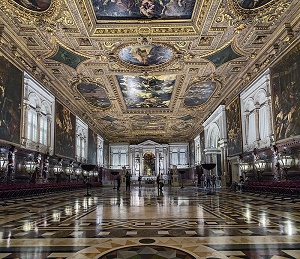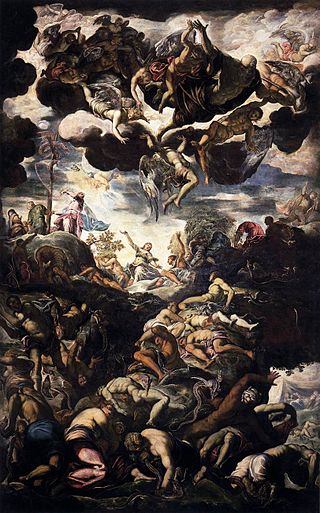


Salone Maggiore of the Scuola Grande di San Rocco
Where Gabrieli spent the majority of his career as well as St. Mark's Basilica
Built 1515-60 in Venice
Paintings by Tintoretto and Domenico added 1564-87
Source: Wikipedia
Born in Venice between 1554 and 1557, Giovanni Gabrieli continues the Venetian school into the late Venetian Renaissance and early baroque. Though he wrote some secular works, sacred music for occasions (not liturgical) was his main concern. Strongly disposed to compose for groups of instruments like brass, he never wrote a Mass which only instrumental accompaniment would have been organ. He was nephew to composer, Andrea Gabrieli, who may or may not have helped raised him, though likely mentored him. Albeit unknown, being related to Andrea may have found him composing at least as a student by 1570 as a teenager. He later studied with Orlande de Lassus in Munich where he remained until about 1579. The year of 1584 found Gabrieli in Venice where he replaced Claudio Merulo as lead organist at Saint Mark's Basilica in 1585. He would remain at Saint Mark's the remainder of his life, as well as at the Scuola Grande di San Rocco where he was also principal organist. The Scuola Grande di San Rocco is one of the six Scuole Grandi built by wealthy Venetians in order to patronize as they would, and houses paintings by masters of the Venetian school, Tintoretto (1518-94) and son, Domenico (1560-1635), executed between 1564 and 1587. It was 1578 when the Confraternity of St. Roch there established itself. These large schools to become institutions to Venice differed from the small (scuole piccole) insofar as hundreds of the latter would eventually be formed by tradesmen and the like of lesser means than those behind such as the Scuola Grande di San Marco, another large school considerably older than at San Rocco, having been originally built about 1260.

Miracle of the Bronze Serpent Tintoretto
Oil on canvas 1575-1576
On the ceiling of the Scuola Grande di San Rocco Venice
Source: Wikipedia
In 1587 several of Giovanni's compositions appeared with the most by Andrea in 'Concerti di Andrea, et di Gio. Gabrieli, organisti della sereniss'. "Ch" numbers for Gabrieli are from Richard Charteris' 1996 'Giovanni Gabrieli (ca.1555–1612): A Thematic Catalogue of his Music with a Guide to the Source Materials and Translations of his Vocal Texts'. This is a painstakingly thorough and highly prized work (as most composer catalogs are). Arranged by theme, however, numbers little reflect a sequential chronology of the whole.
'O Magnum Mysterium' Motet a 8 by Giovanni Gabrieli Ch.3
No.33 of 'Concerti di Andrea, et di Gio. Gabrieli, organisti della sereniss' 1587
Gentlemen of the Chappell / His Majestys Sagbutts & Cornetts / Peter Bassano
Among Gabrieli's more illustrious accomplishments was his volume of motets, 'Sacrae Symphoniae' ('Sacrae Symphoniae I'), published in 1597 and gaining him his hour of power throughout Europe. 'Sacrae Symphoniae' is among the earliest developments of the symphony, also containing a couple of the earliest sonnets (musical). Church music had for centuries been composed for only voice accompanied by organ. Upon the arrival of polyphony other instruments began to see use in festive services beyond the liturgy. However, the arrival of Protestantism (Luther 1517) resulting in the Catholic Counter-reformation (Council of Trent 1545) had wrought a conservative piety in music careful to trim away all which wasn't needful to humbly express the glory of God. This was a cleaning of the slate of polyphony gone too far, occasioning a competition in dead sober purity, as it were, between the music of the Protestant and Catholic Churches. Such remained the case in Gabrieli's time, distinguishing his symphonae the more from amidst an age of solemnity going for baroque.
As for secular music, instruments had served only supportive roles for the last few hundred years. Works were written for voice and any instrumental accompaniment, too minor a matter to address in scores, could do as it liked. But as Europe transitioned from the late Renaissance toward baroque via contest of the best means to achieve the best counterpoint (relationships between parts), instrumentals in their own right began to appear. One way in which instruments first received attention in composition was the basso continuo, a bass line commonly performed by organ or viol to become fundamental to baroque. By Gabrielli's time music was being written not only for solo lute or organ, but consort (small chamber ensemble) as well. Gabrieli's symphoniae for slightly larger ensembles included parts for such as cornetti and trombones, that in mixture with the challenge and trademark of composing at St. Mark's, being double choirs.
'Sacra Symphonia' contained two among the earliest sonatas known as the 'Sonata pian e forte' Ch. 175 and 'Sonata octavi toni a 12' Ch. 184. It is thought that the sonata was first called such in 1561 ("sonare" = Italian for "to sound"), distinguishing them as instrumental pieces (: lute) from cantatas (songs). The sonata, however, wouldn't develop into a major vehicle for another eighty to hundred years via baroque composers such as Arcangelo Correlli and Johann Kuhnau when two kinds of it began to appear: the sonata da chiesa (church sonata) and the sonata da camera (chamber sonata). The sonata's first treatment in literature wasn't until 1710, appearing in Brossard's 'Dictionaire de Musique' that year.
'Sonata pian e forte' Sonata by Giovanni Gabrieli Ch.175
No.33 of 'Sacra Symphonia I' 1597
Bayerische Staatsoper/Zubin Metha
'Sonata octavi toni a 12' Sonata by Giovanni Gabrieli Ch.184
No.59 of 'Sacra Symphonia I' 1597
Gabrieli Players
About 1606, nine years after publishing 'Sacra Symphonia', Gabrieli fell too ill to work, appointing deputies to execute what he couldn't. He died on 12 August 1612 due to a kidney stone. Among posthumous publications arrived 'Canzoni e Sonate' in 1615 containing four sonatas like 'Sonata XVIII' Ch.211 and 'Sonata XXI: Con Tre Violini' Ch. 214. Also arriving in 1615 was 'Sacrae Symphoniae Liber Secundus' ('Sacrae Symphoniae II'), as highly esteemed as the first.
'In Ecclesiis' Motet a 14 by Giovanni Gabrieli Ch.78
No.26 of 'Sacra Symphonia II' Pub posthumously 1615
Taverner Choir, Consort & Players / Andrew Parrott
'Magnificat à 14' Magnificat by Giovanni Gabrieli Ch.79
No.27 of 'Sacra Symphonia II' Pub posthumously 1615
Green Mountain Project directed by Jolle Greenleaf (soprano) / Scott Metcalfe (violin)
In bridging the latter years of the musical Renaissance to idiom baroque, Gabrieli also culminated the influence of the Venetian school since its founding by Willaert in 1527. Baroque on a map, anyway, meant Italy.
Sources & References for Giovanni Gabrieli:
Chris Morrison (All Music)
VF History (notes)
Audio of Gabrieli:
Internet Archive (Canzonas and Sonatas from Sacrae Symphoniae by His Majestys Sagbutts & Cornetts 1997)
Compositions: Corpus: Wikipedia English Wikipedia German
Compositions: Individual (by "Ch" number):
Ch. 78 (In Ecclesiis a 14 / in Sacrae Symphoniae II pub posthumous 1615):
Ch. 175 (Sonata pian e forte / in Sacrae Symphoniae I pub 1597):
Ch. 184 (Sonata octavi toni a 12 / in Sacrae Symphoniae I pub 1597)
Publications: Richard Charteris ("Ch" numbers):
Giovanni Gabrieli (ca.1555–1612): A Thematic Catalogue / 1996:
Book Depository Brigham Young University
Publications: Gabrieli: Corpus: Wikipedia English Wikipedia German
Publications: Gabrieli: Editions: American Institute of Musicology
Publications: Gabrieli: Individual:
Canzoni e Sonate (comp no later then 1612 / pub posthumous 1615)
Concerti di Andrea, et di Gio. Gabrieli, organisti della sereniss (pub 1587)
Sacrae Symphoniae I (pub 1597): IMSLP Wikipedia
Sacrae Symphoniae II (comp no later then 1612 / pub posthumous 1615)
Recordings of Gabrieli: Catalogs:
Recordings of Gabrieli: Select:
The Canzonas and Sonatas from Sacrae Symphoniae 1597 (His Majestys Sagbutts & Cornetts / Hyperion CDA66908 / 1997:
Scores / Sheet Music: Corpus: IMSLP Musicalics
Scores / Sheet Music: Individual:
In Ecclesiis a 14 (Ch. 78 in Sacrae Symphoniae II pub posthumous 1615)
Magnificat à 14 (Ch. 79 in Sacrae Symphoniae II pub posthumous 1615)
The Scuole Grandi of Venice:
In Venice Today Renaissance Rules
Scuola Grande di San Rocco Smart History
The Sonata:
Wikipedia Wikipedia (composers)
Bibliography:
Richard Charteris (The Performance of Giovanni Gabrieli's Vocal Works / Music & Letters Vol 71 / 1990)
Authority Search: VIAF World Cat
Other Profiles:
Further Reading: Discouraged Use of Instruments in the Liturgy (except organ):
Encyclopedia (organ)
Classical Main Menu Modern Recording
hmrproject (at) aol (dot) com